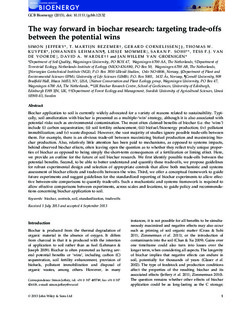| dc.contributor.author | Jeffery, Simon | |
| dc.contributor.author | Bezemer, Martijn | |
| dc.contributor.author | Cornelissen, Gerard | |
| dc.contributor.author | Kuyper, Thomas W. | |
| dc.contributor.author | Lehmann, Johannes | |
| dc.contributor.author | Mommer, Liesje | |
| dc.contributor.author | Sohi, Saran P. | |
| dc.contributor.author | van de Voorde, Tess F.J. | |
| dc.contributor.author | Wardle, David A. | |
| dc.contributor.author | Van Groeningen, Jan Willem | |
| dc.date.accessioned | 2017-09-05T10:37:10Z | |
| dc.date.available | 2017-09-05T10:37:10Z | |
| dc.date.created | 2014-03-27T09:44:00Z | |
| dc.date.issued | 2015 | |
| dc.identifier.citation | Global Change Biology Bioenergy. 2015, 7 (1), 1-13. | nb_NO |
| dc.identifier.issn | 1757-1693 | |
| dc.identifier.uri | http://hdl.handle.net/11250/2453173 | |
| dc.description.abstract | Biochar application to soil is currently widely advocated for a variety of reasons related to sustainability. Typically, soil amelioration with biochar is presented as a multiple-‘win’ strategy, although it is also associated with potential risks such as environmental contamination. The most often claimed benefits of biochar (i.e. the ‘wins’) include (i) carbon sequestration; (ii) soil fertility enhancement; (iii) biofuel/bioenergy production; (iv) pollutant immobilization; and (v) waste disposal. However, the vast majority of studies ignore possible trade-offs between them. For example, there is an obvious trade-off between maximizing biofuel production and maximizing biochar production. Also, relatively little attention has been paid to mechanisms, as opposed to systems impacts, behind observed biochar effects, often leaving open the question as to whether they reflect truly unique properties of biochar as opposed to being simply the short-term consequences of a fertilization or liming effect. Here, we provide an outline for the future of soil biochar research. We first identify possible trade-offs between the potential benefits. Second, to be able to better understand and quantify these trade-offs, we propose guidelines for robust experimental design and selection of appropriate controls that allow both mechanistic and systems assessment of biochar effects and trade-offs between the wins. Third, we offer a conceptual framework to guide future experiments and suggest guidelines for the standardized reporting of biochar experiments to allow effective between-site comparisons to quantify trade-offs. Such a mechanistic and systems framework is required to allow effective comparisons between experiments, across scales and locations, to guide policy and recommendations concerning biochar application to soil. | nb_NO |
| dc.language.iso | eng | nb_NO |
| dc.rights | Navngivelse 4.0 Internasjonal | * |
| dc.rights.uri | http://creativecommons.org/licenses/by/4.0/deed.no | * |
| dc.title | The way forward in biochar research: targeting trade‐offs between the potential wins | nb_NO |
| dc.type | Journal article | nb_NO |
| dc.type | Peer reviewed | nb_NO |
| dc.source.pagenumber | 1-13 | nb_NO |
| dc.source.volume | 7 | nb_NO |
| dc.source.journal | Global Change Biology Bioenergy | nb_NO |
| dc.source.issue | 1 | nb_NO |
| dc.identifier.doi | 10.1111/gcbb.12132 | |
| dc.identifier.cristin | 1125187 | |
| cristin.unitcode | 192,1,2,0 | |
| cristin.unitname | Institutt for miljøvitenskap | |
| cristin.ispublished | true | |
| cristin.fulltext | original | |
| cristin.qualitycode | 1 | |

